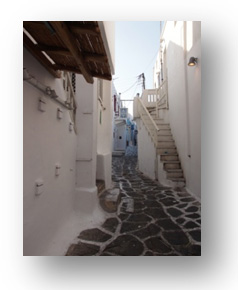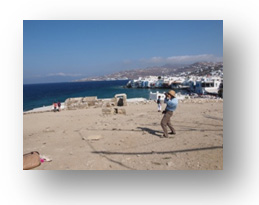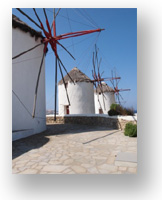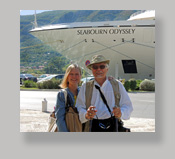MYKONOS 10-1-12
It is hard to tell anyone that you are going to the Greek Isles without them asking if you are going to Mykonos. It is the mental picture everyone seems to have of a Greek Isles with square houses, whitewashed buildings, intensely blue doors and window frames, narrow winding streets, windmills, seaside restaurants, the whole nine yards. 
A couple of things we learned were interesting. The buildings are white because for hundreds of years the residents white washed their structures inside and out with lime. Happily for them, lime was an excellent disinfectant. Today local law requires that the buildings be white. Anything that's wood, like window frames and doors, can be painted any color. The predominant colors are in the blue range: sapphire, teal, and turquoise, but you can also see muted red and green with a sprinkling of yellow.
 The square building shape comes from the fact that it doesn't rain a lot on the island and water is scarce. The flat roofs are shaped to collect any rain, which then gets stored in water cisterns. The streets are said to have been built intentionally narrow and winding to confuse pirates who might invade the city. The streets were also laid out so that those which do not face the waterfront (and the wind) are somewhat protected from the wind.
The square building shape comes from the fact that it doesn't rain a lot on the island and water is scarce. The flat roofs are shaped to collect any rain, which then gets stored in water cisterns. The streets are said to have been built intentionally narrow and winding to confuse pirates who might invade the city. The streets were also laid out so that those which do not face the waterfront (and the wind) are somewhat protected from the wind.
But speaking of wind, not well advertised is the WIND. It blows from morning to night and is welcomed by the residents as nature's air conditioning. Without the wind, on the few days it happens, the air is still, hot, and humid. With the summer's north wind, the air is dry and tolerable.
There are churches and chapels everywhere (Greek Orthodox) - over 1,000 in all and they are interspersed with the homes and shops. We saw a number of examples where the tables of the outdoor restaurants went almost to the front door of the church.
 The windmills are almost all gone. There is that frequently photographed group of five (a sixth is there but only the tower part; the blades are gone) but none of them is operable. On the hill around the town there's still a windmill here and there, but not all that many are left. Our guide showed us one windmill tower (no blades) which she said an American had purchased in the 1950's and turned into a home. It may be a delightful home inside but it had only a few windows and those were very small.
The windmills are almost all gone. There is that frequently photographed group of five (a sixth is there but only the tower part; the blades are gone) but none of them is operable. On the hill around the town there's still a windmill here and there, but not all that many are left. Our guide showed us one windmill tower (no blades) which she said an American had purchased in the 1950's and turned into a home. It may be a delightful home inside but it had only a few windows and those were very small.
The overall ambiance of Mykanos is of a place that has seen better days as a quality tourist and jet set location. Shops everywhere sell much the same items and there's a cafe every few feet on the waterfront. How they all stay in business is a mystery.
Our guide told us that it is the custom in Greece, on the first of every month, to wish each other "kalomina". It means, "have a good month". So, everyone, KALOMINA!



